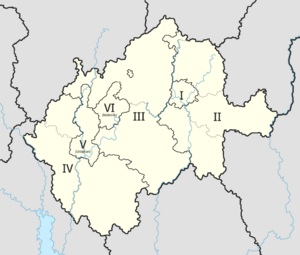Grand National Assembly of Walneria
Grand National Assembly of the Confederacy of Walneria Volkomaine Nacionálfŕzamlunk Rósberisses Aidgenosënssaftes | |
|---|---|
 | |
| Type | |
| Type | |
| History | |
| Founded | October 12, 1976 |
| Structure | |
| Seats | 250[a] |
 | |
Political groups | Currently not established
|
Length of term | No longer than 6 months |
| Elections | |
Scorporo
| |
First election | 15 July 1978 |
Last election | 4 June 2016 |
Next election | No later that 2036 |
| Motto | |
| Régi pravnik ai virtess strenk | |
| Meeting place | |
 | |
| Ahranian Hall, Tyrámen Castle | |
| Website | |
| www.nfras.wn/vv | |
| Footnotes | |
| |
The Grand National Assembly of the Confederacy of Walneria (Walnerian: Volkomaine Nacionálfŕzamlunk tes Rósberisses Aidgenosënssaftes) is the non-standing constitutional assembly of the Confederacy of Walneria. It is the only organ, which is allowed to remove, edit or amend parts of sections 1 and 9 of the Constitution of Walneria. The regular National Assembly has the right to call for a referendum, which serves a similar function like the Grand National Assembly.
History
The decision to establish the Grand National Assembly as a constitutional convention was made in 1976, following the realization, that despite the fact, that Walneria stayed neutral during the Second Argic War, the need to update the constitution can be misused maliciously if it is done by a flawed parliament longer after elections. A government made up by a coalition of the National party of Walneria and Christian Democratic Party of Walneria agreed to pass a constitutional law, establishing the authority of the Grand National Assembly over certain parts of the constitution in which a direct involvement could directly threaten the foundation of democracy, and deciding, that the next election, the 1978 Walnerian parliamentary election, would be the first after which the Grand National Assembly would convene.
The first Grand National Assembly consisted of the elected members of the Council and the Senate, and approved the amendment as well as postulating, that the Grand Assembly should meet at least once every 5 convocations of the parliament, and that it can be called with any elections when the qualified majority of both of the parliamentary chambers decides for it.
After the 1988 merger of the two chambers, the Grand National Assembly was amended in a way, that it was extended to 250 members, so a parliament doesn't maliciously take the advantage of the situation all on its own. Two following convocations (so far) were elected under this system (2nd Convocation in 1996 & 3rd Convocation in 2016)
Convocations
| Convocation | Election | Seats | Strongest party | |
|---|---|---|---|---|
| 1st Convocation | 15 July 1978 | 300[a] | National Union Party | |
| 2nd Convocation | 2 March 1996 | 250[b] | Union of National Minorities | |
| 3rd Convocation | 4 June 2016 | 250[b] | Liberal Party of Walneria | |
| 4th Convocation | No later than 2036 | 250[b] | — | |
Elections
Direct elections
The Grand National Assembly is elected in one of every five parliamentary elections. That means, that every fifth convocation of the National Assembly starts with the assembling of the Grand National Assembly. Unlike the regular national assembly, which is elected in 6 multi-member constituencies, Grand National Assembly, utilizes Scorporo.
Outside of the regular distribution of 200 seats through the Imperiali quota in regions and Hare quota in autonomies respectively (the number of reserved seats for each autonomy has been increased to 10), the remaining 50 seats are elected in single-member constituencies through the first-past-the-post.
Indirect elections
After the meeting of the Grand National Assembly concludes and at least 2/3 of the members agree, that the constitutional needs have been satisfied, the 130 most successful candidates (those with the most prefferential votes) continue as the regular members of the newly established National Assembly, no new elections are held (so the outcome is the same as if there were only 130 seats to be elected instead of the 200 elected through proportional representation).
Members elected in single-member constituencies, as well as those who did not succeed in getting into the National Assembly are given seats in their regional assemblies (the increase is usually between 7 and 20 members in each respective region). As the multi-member constituencies span more than a single region, the membership in local assembly is decided through a permanent residency of the member in question. Out-of-region candidates for autonomies are still granted seat in the autonomous legislature no matter the actual residency.
Voting
All votes on the questions of the constitutional amednment have to be passed with at least 2/3 majority (167 votes). Regular votes regarding functionality, such as brakes, adjourning of the respective day's meeting etc., requires an obsolute majority (126 votes).
Past convocations
| 1st Convocation | 2nd Convocation | 3rd Convocation |
|---|---|---|

|

|

|
See also
- Government of Walneria
- National Assembly of Walneria
- Evolution of the Parliament of Walneria
- Ustokan National Council
- Malenik National Council

